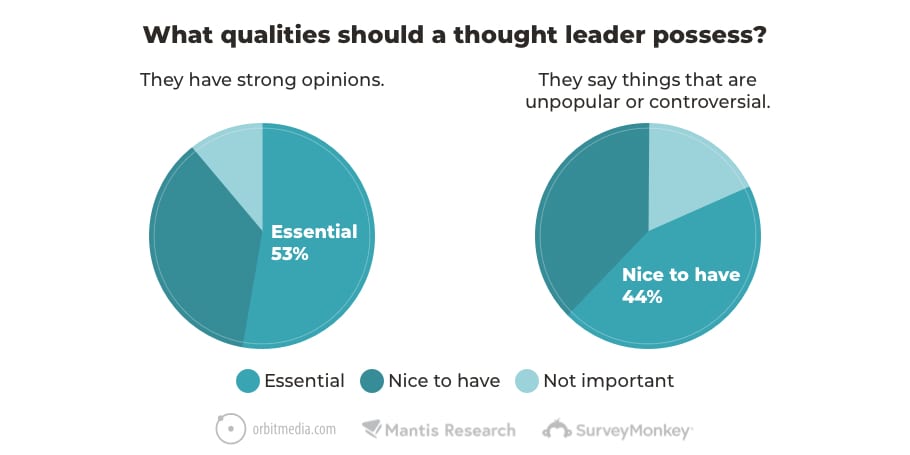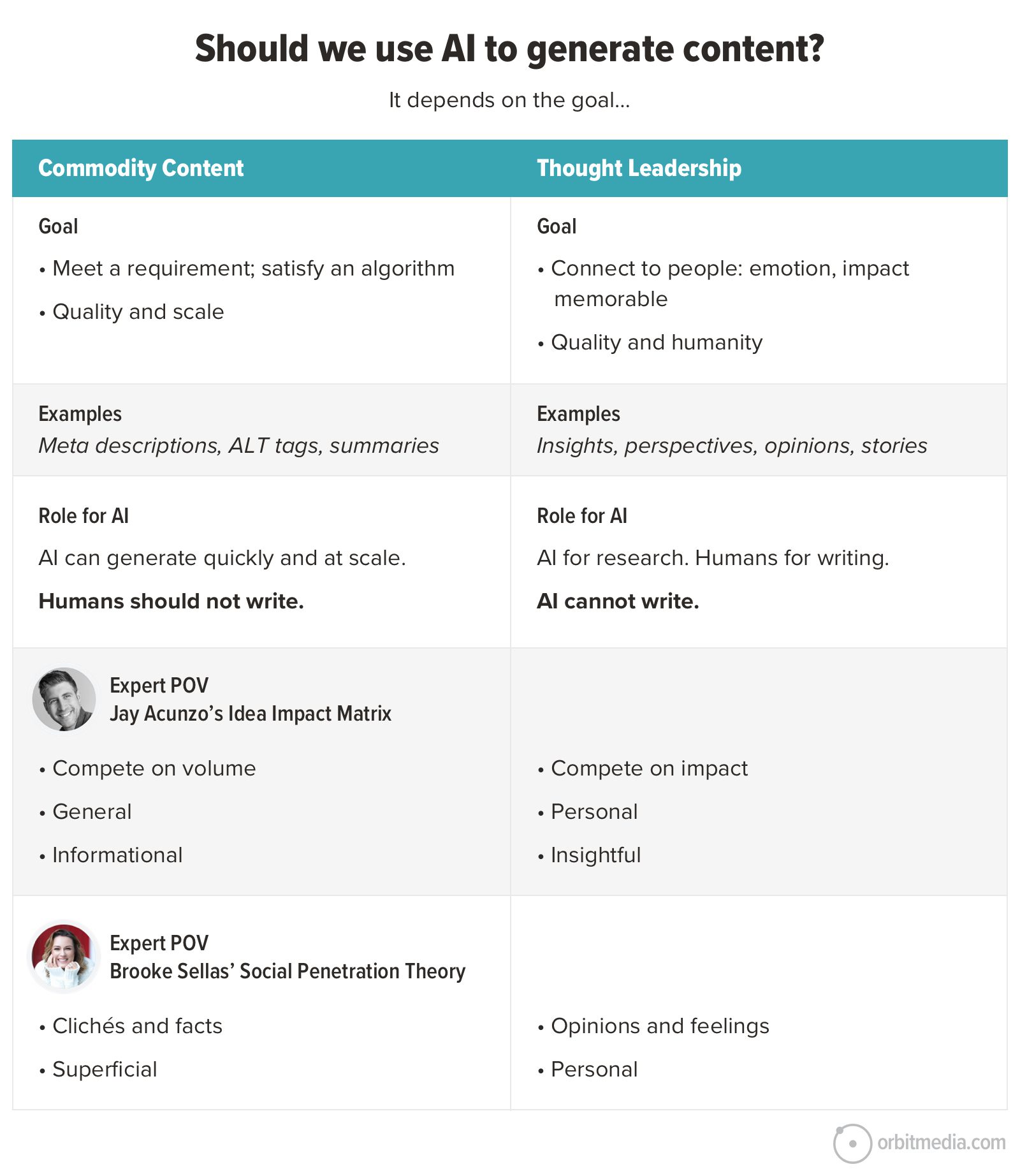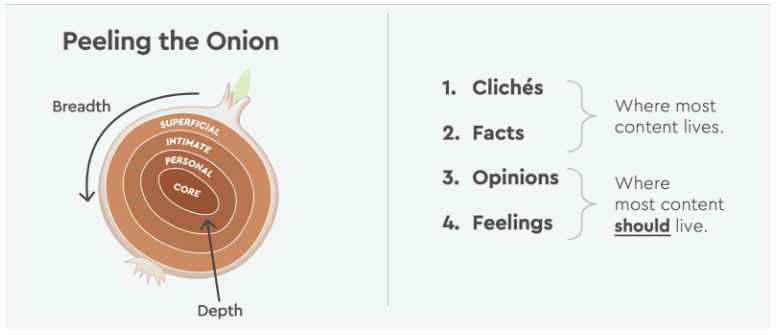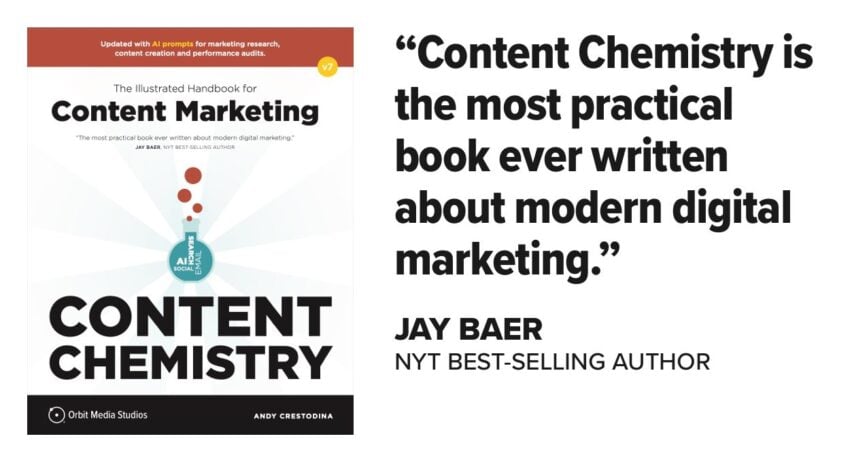AI is famous for writing. Give it a prompt and it responds with a detailed article …and it’s completely impersonal, undifferentiated and boring. It’s no surprise. AI is really just summarizing what it found on the web.
Humans are famous for opinions. Give a human a point of view and they respond with their own perspective …and it’s personal, specific and relevant. It’s hard for people not to form an opinion when given the chance.
This explains why AI can’t create thought leadership content. It does well with how-tos and best practices, but it has no opinions or beliefs. It has no experiences. AI doesn’t care about anything. Only humans care.
AI = Average Information
Thought leadership content is special. It’s about taking a stand, which AI cannot do. But AI can help you find thought leadership topics.
Today we are dissecting the difference between thought leadership and other forms of content marketing, and sharing prompts that may help you create thought leadership content by finding the topics that you and your audience truly care about.
- What is thought leadership?
- Thought leadership vs commodity content
- AI prompts for thought leadership
- AI prompts for commodity content
- Why thought leadership works so well
- Responsible AI usage
- Humanizing your content
But first, let’s define the term. What’s thought leadership content anyway?
Most content marketing is not thought leadership
A lot of content marketing (including most of ours) is purely educational. “How-to” articles may come from a point-of-view, they might include little stories, but mostly, they aren’t based on beliefs. They don’t make the case for anything.
True story: I once saw Seth Godin present at a conference. It was a beautiful summer afternoon in a top-floor event space in Chicago’s Printers Row. He talked for 30 minutes, then took questions for 30 minutes. I was the first to raise my hand. Thought leadership had been on my mind, so I couldn’t wait to ask my question.
 |
Seth Godin“Thought leadership always creates tension. It’s about making assertions and you have to be willing to be wrong. You can be certain that people will disagree.“ |
I love how Seth sets the bar high. If you can’t disagree with it, it isn’t true thought leadership. Because true thought leadership comes from personal experience. It takes a stand. A thought leader takes a position for (and therefore against) something. A thought leader draws a line in the sand.
We confirmed this definition of a research piece we conducted with Mantis Research and Survey Monkey years ago. We asked 480 marketers what qualifies as thought leadership. Most agreed that “strong opinions” were essential.
AI has no life experiences, feelings or opinions. But these are easy to add to anything you write. In just the last few paragraphs, you’ve read several sentences that could never be written by an AI.
- “It was a beautiful summer day in a top-floor event space in Chicago’s Printers Row” (little stories)
- “Purely educational content is not thought leadership” (take a stand)
- “I love how Seth sets the bar high.” (share emotion)
AI can’t write thought leadership content. But it can be used to save you time, spark inspiration, and create general, summarized information, such as commodity content.
Thought leadership vs commodity content
There is such a thing as commodity content, some of which needs to be produced at scale. It’s the opposite of thought leadership content. It’s mostly created to satisfy a requirement, not connect with humans.
Commodity content is generic, easily produced and undifferentiated from other information on the same topic. AI is great for writing this kind of content. It’s a wonderful time-saver. Humans should not do this job.
But commodity content lacks a point of view. It makes no personal connection. It is not memorable. It has no impact.
Thought leadership has a strong point of view, based on beliefs. It often evokes emotion and creates tension. The reader can agree or disagree. AI cannot write this kind of content. Only humans can.
The difference is quantity versus quality, but there’s more to it. Should we use AI for content creation? It depends on the goal. Is the goal simply information? Or is the goal personal and persuasion?
Answer that first and it becomes clear: some content should always be written by AI. For other content, AI has only a research role, if any.
Using AI for thought leadership content
 |
Jay Baer, Thought leader and tequila influencer“The problem isn’t that AI can do what marketers can do. The problem is that marketers keep doing what can be done by an AI.” |
Jay is right. We should be doing things that AI can’t do. What can you write that AI can’t? Your experiences, your perspective, your stories, your point of view.
But which of your perspectives would your readers be interested in? AI can help. It can find ideas for thought leadership content where you can add your own human creativity, opinions and point of view.
Here are eleven prompts for discovering topics for thought leadership articles. We’ve put them in three groups: topics that trigger emotions, topics that your audience hasn’t considered, topics that others have avoided.
Run these prompts, consider the responses thoughtfully, then decide for yourself: where can my brand take a stand?
AI for finding provocative topics
Our first four prompts will uncover the topics that start conversations. They are very likely to trigger engagement, which is great for your social media strategy. Post a question. Run a poll. Or be a leader. You may find opportunities to lean into your biases with an opinion piece.
Some will be silly, some will be too controversial (radioactive) and a few may inspire you.
What are some relatively mundane, almost trivial topics that [job title] have very strong opinions about?
What future predictions about [industry] would [job title] find hard to believe?
What common advice or best practice in [industry] might actually be harmful or ineffective?
What are some unpopular or contrarian views on current trends in [industry]?
AI for finding gaps in your readers’ knowledge
This next set of prompts helps you find topics that your readers hadn’t thought about before. And if you find a topic your reader hasn’t considered, you found an opportunity to be a thought leader.
What key perspectives or insights about [industry] are [job title] often unaware of?
What false beliefs are common in the [job title]’s industry? What true things do they often dismiss as false?
What counterintuitive solution to a common problem would [job title] find surprisingly effective?
Which of [job title]’s common fears or concerns is exaggerated or misplaced?
AI for finding content gaps in your industry
These final three prompts uncover the topics that may be missed by the big blogs. This is an AI-only method. It’s just not possible for a human to read everything in their industry and then identify what isn’t there.
Often, these are the topics that writers and editors skip because they don’t want to take a stand. That makes them counter-competitive topics, wide open for you to jump in with a new point of view.
What topics fascinate [job title] but rarely appear in industry blogs?
What counter-narrative views in [job title]’s industry are rarely discussed by bloggers or thought leaders?
What questions make people in [job title]’s industry uncomfortable or unwilling to answer?
Find anything interesting? Anything that aligns with your content strategy? Ready to dip your toes into the thought leadership waters? Your readers may be ready to take the dive with you. Connect the topic to a story and write something that only you can write.
If you are inspired, stop reading, close this tab and start writing.
If you want to learn how thought leadership works and why only humans can write it, read on…
Using AI for commodity content
Now that we’ve covered AI for thought leadership, let’s switch gears to using AI for commodity content.
Some AI powered tools are perfect for generating certain commodity content at scale.
- AI Alt Text Generator will generate ALT tags for thousands of images automatically
- Screaming Frog will generate meta descriptions for thousands of URLs automatically
This is purely an efficiency play without any AI ethical considerations.
And for the content marketer, artificial intelligence can help produce drafts for things that are important, but lower-value, such as YouTube descriptions, which can be tedious to write. And nobody reads those anyway. These little keyword-focused summaries are more for the YouTube algorithm than human readers.
You are a YouTube SEO expert and writer. Create a YouTube video description that is clear, engaging, detailed but concise. It should be around 1,000 words total. I’m giving you a transcript, draft title and target keyphrase. Your instructions:
1. Intro (4–5 sentences) – Summarize what the video covers, who it’s for, and what problem it solves or benefit it provides. Use natural phrasing that reflects the title’s keyphrase.
2. Overview (4–5 short paragraphs) – Outline the main topics from the video in order. Keep it structured, readable, and aligned with search intent. Avoid repetition.
3. Closing (1–2 sentences) – Invite viewers to like, comment, and subscribe. Optionally mention related or upcoming videos.
4. Link to Article: Add this line after the overview:
“Looking for more? Read the full article here: [Insert link]”
5. Hashtags: Suggest two relevant, specific hashtags based on the title (avoid one-word tags).Guidelines: • Write in first person plural (“In this video, we show you how to…”). • Use clear, natural language — no buzzwords or keyword stuffing. • Align naturally with the main keyphrase. • Use short paragraphs for readability. • Add bullet points only if they improve clarity.
[upload transcript, input the draft title and target keyphrase]
Of course, you’ll need to read the draft carefully. Fix the tone, turn the bullet list into timestamps and add links to your related content. But you saved some time, which is good. Your time is better spent writing or recording something new.
Do you remember that scene in Good Will Hunting when Robin Williams and Matt Damen are sitting on the park bench? “I bet you can’t tell me what it smells like in the Sistine Chapel.” That scene still gives me chills.
Why thought leadership works so well…
Thought leadership has the greatest impact precisely because of its humanity. It’s not just information, it’s emotion. It isn’t just read, it is remembered. Our friend Jay Acunzo explains the difference beautifully.
 |
Jay Acunzo, Co-founder of Creator Kitchen“AI and people both rely on LLMs as their foundations. AI has large language models. People have little life moments.“ |
Social media expert and good friend, Brooke Sellas, uses the Social Penetration Theory to explain why this kind of personal approach to content connects so well. This model describes the degrees to which content can connect, from the superficial (clichés and facts) to the core (opinions and feelings).
 |
Booke Sellas, Founder of B Squared Media and Author of Conversations that Connect“As humans, we haven’t changed the way we build relationships: vulnerability → trust → intimacy. Those are the basic tenets of any real connection. AI, however, lacks each one of those things, and (for now) doesn’t have the emotional depth needed to foster authentic bonds.“ |
AI is great for facts, information and commodity content. But the core is where humans connect. It’s those deeper messages that trigger loyalty and love. It’s the words that take a bit of bravery to write.
Jay Acunzo, uses the Idea Impact Matrix to explain the same difference between information and emotion, commodity content and thought leadership. He puts it all content on a two-by-two matrix, with value and originality as the axes.
The top right is both insightful and personal. Here the content creator uses little personal stories connected to insights. Here, creators write small stories with big impact. And these are the pieces that Jay suggests using personal experiences to create content that connects to insights. That content may have a common structure: “This happened… which made me realize …and that’s the thing about…” Obviously, AI doesn’t write that way because it has no experience.
Using AI responsibly
Here’s an example of generative AI at its worst: social media comments.
Comments are the exact opposite of commodity content. A comment is a reaction, an interaction, a response. If you use AI for this, you are a spammer.
This is what AI comment spam looks like on LinkedIn. What a nightmare.
Let’s all commit to being thoughtful about when and how to use AI generated content in digital marketing. Let’s decide when it’s better and when it’s far worse. What it makes possible and what is totally impossible for AI technology to do.
- Never write commodity content by hand
- Never try use AI to write a thought leadership piece
- Welcome AI into the brainstorming process
- When content needs to connect, keep it human with plenty of stories, opinions, emotion and belief.
Thought leaders need to do their research too. And AI platforms are a useful tool for researching topics. But a leader doesn’t use tools to do their thinking. They think for themselves and use their own unique perspective and personal experiences to give life to their writing.
Impossible for AI, easy for humans
It’s very easy to differentiate content from AI, because you are human. You have opinions and beliefs. It may take a bit of courage to stick your neck out on a topic, but that hesitation is human. And if you feel it, you may be taking a step toward becoming a thought leader.
You don’t have to take on a controversy. Just add a little bit more of yourself into your next piece. You’ll connect with your readers and set yourself apart in a sea of sameness. Here are three simple ways to humanize your content:
- Take a stand, because AI has no opinions
- Collaborate, because AI has no friends
- Record yourself, because AI has no face
It’s exactly those human elements that make content memorable and compelling. We’ll close with another quote from Jay Baer. This connected with me in ways that AI never will.
“You can’t be a successful content creator unless you’re someone’s favorite content creator”









